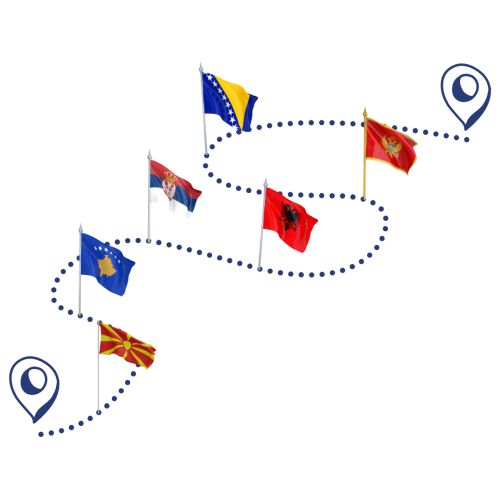FREQUENTLY ASKED QUESTIONS
Eligibility of Applicants and Partners
1. Are sport NGOs, like non-profit sports clubs, eligible to apply? Can student associations and youth associations participate?
○ Yes, if they are registered under national laws listed in the Gudelines and have at least 2 years of experience.
2. Is a CSO with less than 2 years of existence eligible as a partner?
○ No.
3. Can foundations be partners if they provide co-funding?
○ Yes, if registered under the laws specified in the guidelines, and have at least 2 years of experience.
4. Can a non-formal women’s network be a partner?
○ Only in informal, non-financial partnerships. For financial partnerships, formal NGO registration is required.
5. Can public institutions (schools, libraries, etc.) be official project partners?
○ No, but they can support project activities informally.
6. Can the Ministry of Culture or other national public funds be used as co-funding sources?
○ Yes.
7. If supported by a regional fund, can we apply for the national call?
○ No.
8. Is co-financing from private sector partners allowed?
○ They can’t be official partners but may contribute financially as associates.
Project Activities and Thematic Fit
9. Can we propose starting a new social enterprise?
○ Yes, if deemed viable by your organization.
10. Is a student exchange between Croatia and Serbia eligible under Lot 3?
o No, only national activities are eligible.
11. Is investigative journalism eligible?
○ Yes, if it aligns with one of the three thematic pillars.
12. Is publishing an educational tool (e.g. a handbook) eligible?
o Yes, if the topic aligns with the call.
13. Are startup competitions with awards eligible?
o No, they are not eligible, please refer to the Gudelines – section 2.4. Eligibility of activities
Co-Funding
14. Are in-kind contributions accepted as co-financing?
o No.
15. Can co-funding come from another project (e.g. EU funded)?
o Yes, if activities are aligned.
16. Does staff work only partly on the project count as co-financing?
o If the activities of two projects are aligned, then the salary of non-BOOST project can be used as co-financing.
17. What if the applicant contributes part of the total budget—does it count toward the €20,000 grant minimum?
o No, €20,000 refers to the grant portion only. Co-funding is additional.
18. Is the total available budget €24,000 plus 20% contribution
o Yes.
19. Can we directly budget things that would typically be indirect costs, i.e. office rent, office supplies, etc?
o In the Equipment portion of the budget that can cover small equipment used for budgeting expenses for rent or purchase of equipment or purchase of supplies directly connected with the Action. These costs encompass the procurement of physical goods and resources necessary for the project. Also, this heading includes office maintenance (office rent and utilities). Please remember that for all equipment you need to calculate the depreciation, considering the rules applied in your country (see budget template and explanation, Annex II)
20. Would the use of your own office space and equipment qualify as co-funding for the project?
o While the use of your own office space and equipment is considered an in-kind contribution, such contributions are not accepted as eligible co-financing under this Call for Proposals. Therefore, the required 20% co-financing must be provided in monetary form from other eligible sources.
Budgeting and Financial Questions
21. What percentage of the budget can be used for equipment?
o Check section 3. Equipment and supplies from the budget template and explanation, Annex II (up to 20%).
22. What budget line includes office rent, IT, and consumables?
o Equipment and office maintenance (see budget template and explanation, Annex II).
23. What percentage of the budget can go to salaries?
o Up to 40%.
24. How are "unit" and “# unit" used in the budget template?
o “Unit” is the cost per item; “# unit” is the quantity. Total cost is calculated automatically.
25. Where is the applicant's contribution shown in the budget?
o The budget is presented as a whole; 80% grant + 20% co-financing.
26. Are taxes/VAT eligible costs?
o Eligible VAT is VAT that is not recoverable by any other means.
27. Can indirect costs be used as co-financing?
o No.
28. Do we cover supporting staff (those who are not employed in our organization) in 1. human resources or in another budget category?
o If you hire a project manager or assistant to work on the project for all the duration of the action, this cost will be covered by 1. human resources budget line, if you hire an external expert to work on a specific activity of your action (i.e. trainers, video makers, interpreters…..) these costs will be included in other costs budget line.
29. Are taxes on a service contract an eligible cost?
o Yes.
Registration and Application Process
30. When will we receive registration confirmation?
o It may take a few days. Check your spam folder regularly or write email to: boostgrants@aldaintranet.org.
31. We’ve already registered on the platform for another call. Do we need to re-upload documents?
o No. Additional documents will be requested if needed.
32. Can the registration certificate be uploaded in a local language?
o Yes
Partnerships and Public Sector Involvement
33. Can informal partners (e.g., waste companies) be part of the project?
o Yes, if no financial transactions are involved.
34. Is cooperation with public authorities mandatory?
o Not mandatory but recommended. Alternatives include engaging public representatives (e.g. councilors, schools).
35. Can projects be implemented without local government partnerships due to political barriers?
o Yes, as long as other public participation is ensured.
Procurement and Payments
36. Are there mandatory procurement types?
o Yes, all related to project activities.
37. How many installments will the grant be paid in?
o Usually 2-3 installments for a one-year project.
38. Do we need a separate bank account for the project?
o No, an existing foreign account is acceptable.











